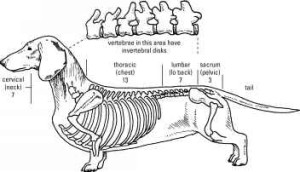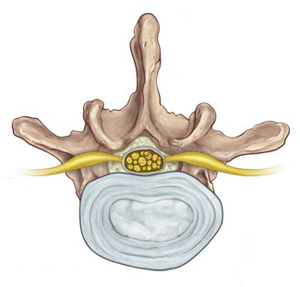For many people, the cutest dog breeds are the small ones; dacshunds, poodles, bichons, shi-tzus and others typically referred to as toy breeds.
Unfortunately these breeds are also over-represented in the caseload of patients with intervertebral disc disease, also referred to by its initials IVDD. It is sometimes called a “slipped disc” or “herniated disc”. It is caused by degeneration of one or more of the shock-absorbing pillow-shaped discs located between the vertebral bones of the spine. These discs can become hardened and stiff (calcium deposits form inside them) causing bulging of the disc into the spinal canal, or they may rupture, letting the soft jelly-like material they contain out into the canal. There is really only enough room for the spinal cord in the spinal canal, so it gets compressed and sometimes irreparably damaged.
When the spinal cord or the nerves passing out of it to the body are compressed, pain and impairment of neural function are the result. Some dogs show minimal symptoms but stop doing things that hurt such as going up or down stairs, jumping on the bed or going about their usual activities. An observant guardian may sometimes notice a change in gait, a wobble or hitch in their step, especially when turning or changing directions. Others may have severe and unrelenting pain and refuse to move, eat or void their bowels or bladder. in the most severe cases there is no pain- all sensation and movement beyond the location of the spinal cord damage is lost, resulting in complete paralysis.
Damage to the spinal cord causes a loss of communication between the brain and the body. Most dogs that have grade 2-4 IVDD will remain permanently impaired, if they are able to regain their ability to walk at all. There are 27 discs (or more in some long-backed breeds such as dachsunds, basset hounds and corgis) between the vertebral bones from the nape of the neck to the tail. Since the disease in a degeneration, multiple discs may be affected. A recent veterinary study at The Royal Veterinary College in the United Kingdom established a relationship between long backs, short legs and IVDD.
Early treatment is critical for IVDD. In cases of unrelenting pain or paralysis, an MRI of the spinal cord to determine location of damage followed immediately by surgery to remove the herniated disc material is usually recommended. Unfortunately this surgery only has a success rate of 50%.
Intensive acupuncture with electrostimulation and physical rehabilitation is essential for return to full function, or as full as posible depending on the extent of spinal cord damage. For back pain only with no loss of nerve function (such as loss of spatial sensation, called proprioceptive deficits) the treatments are started at twice a week and taper quickly to once a month for maintenance. For paralysis the treatments will be daily to every third day until sensation returns. Nursing care for these dogs is critical, as bladder and bowel function is lost as well. Poor hygeine can lead to bedsores, bladder infections and painful skin rashes.
So if you have a long-bodied, short-legged dog in your family, be aware of this devastating disease and keep an eye out for the little signs you might otherwise miss. Regular acupuncture treatments can not only help keep your dog’s back flexible and healthy but the veterinary acupuncturist will check for subtle signs at every visit to catch and treat dysfunction before pain and disability occur.














